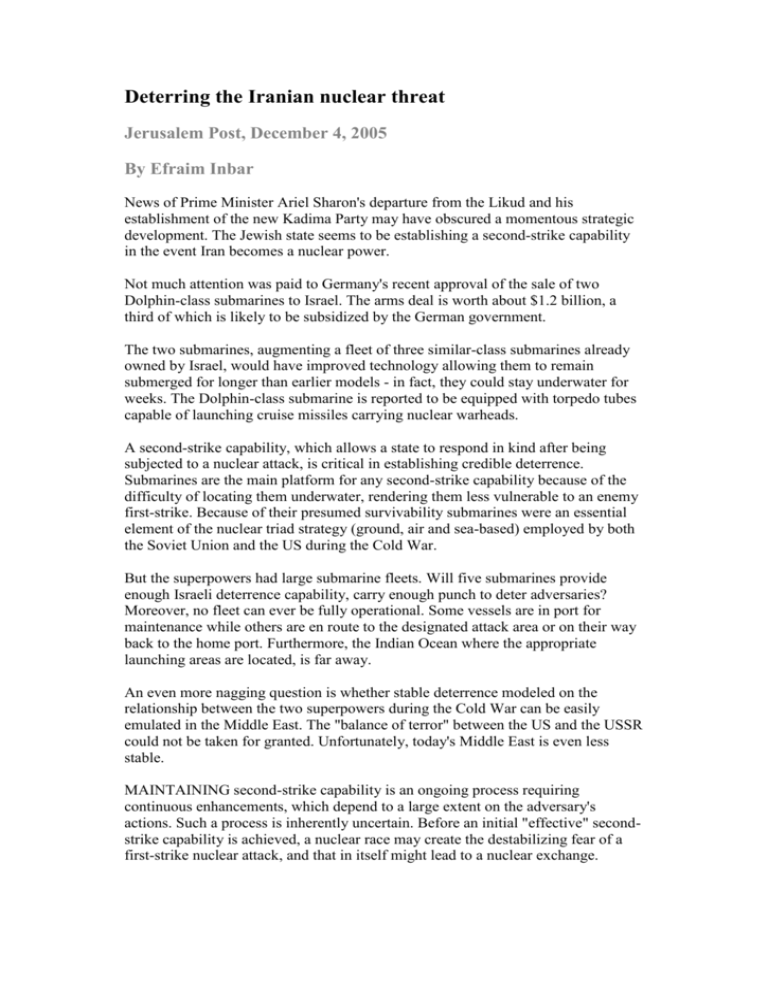Deterring the Iranian nuclear threat
advertisement

Deterring the Iranian nuclear threat Jerusalem Post, December 4, 2005 By Efraim Inbar News of Prime Minister Ariel Sharon's departure from the Likud and his establishment of the new Kadima Party may have obscured a momentous strategic development. The Jewish state seems to be establishing a second-strike capability in the event Iran becomes a nuclear power. Not much attention was paid to Germany's recent approval of the sale of two Dolphin-class submarines to Israel. The arms deal is worth about $1.2 billion, a third of which is likely to be subsidized by the German government. The two submarines, augmenting a fleet of three similar-class submarines already owned by Israel, would have improved technology allowing them to remain submerged for longer than earlier models - in fact, they could stay underwater for weeks. The Dolphin-class submarine is reported to be equipped with torpedo tubes capable of launching cruise missiles carrying nuclear warheads. A second-strike capability, which allows a state to respond in kind after being subjected to a nuclear attack, is critical in establishing credible deterrence. Submarines are the main platform for any second-strike capability because of the difficulty of locating them underwater, rendering them less vulnerable to an enemy first-strike. Because of their presumed survivability submarines were an essential element of the nuclear triad strategy (ground, air and sea-based) employed by both the Soviet Union and the US during the Cold War. But the superpowers had large submarine fleets. Will five submarines provide enough Israeli deterrence capability, carry enough punch to deter adversaries? Moreover, no fleet can ever be fully operational. Some vessels are in port for maintenance while others are en route to the designated attack area or on their way back to the home port. Furthermore, the Indian Ocean where the appropriate launching areas are located, is far away. An even more nagging question is whether stable deterrence modeled on the relationship between the two superpowers during the Cold War can be easily emulated in the Middle East. The "balance of terror" between the US and the USSR could not be taken for granted. Unfortunately, today's Middle East is even less stable. MAINTAINING second-strike capability is an ongoing process requiring continuous enhancements, which depend to a large extent on the adversary's actions. Such a process is inherently uncertain. Before an initial "effective" secondstrike capability is achieved, a nuclear race may create the destabilizing fear of a first-strike nuclear attack, and that in itself might lead to a nuclear exchange. This is all the more probable when warning systems are inadequate and distances between enemies are small. The influence of haste and the need to respond quickly can be extremely dangerous. While it can be argued that Mideastern leaders do behave rationally and are sensitive to costs, their attitudes toward human life hardly conform to Western values. Iranian leaders have said they are ready to pay a heavy price for the destruction of the Jewish state. If true, such an inclination questions the effectiveness of Israeli nuclear deterrence. Israel's reported nuclear option was built to deal with a worst-case scenario of the IDF losing its conventional capability to defend the heartland. Initially, Jerusalem did not envision an Arab nuclear opponent. When such a possibility emerged in Iraq in the late 1970s, the Israeli response was to sabotage the program. It destroyed the nuclear reactor near Baghdad with a preemptive conventional air strike in June 1981. Thereafter, Israel seemed to maintain that a military nuclear program conducted by a hostile state constituted a casus belli warranting preemptive action. Yet the attempt to build a second-strike force indicates that Israel is looking for ways to adjust to a nuclear Middle East, which undermines the credibility of a preemptive posture. Moreover, this effort could send a signal to the Europeans and the Americans of a reduced Israeli threat perception and less urgency in dealing with the prospect of a Iranian nuclear bomb. DOES THE purchase of two additional submarines herald a change in Israeli strategic thinking, which has hitherto stressed dealing with emerging threats, including nuclear, by preemption? This is not necessarily the correct interpretation. In acquiring additional submarines Israel seems to be adopting a greater appreciation of sea power at the expense of its traditional reliance on the Israel Air Force. Israeli strategists have argued for an expanded naval role; and in recent years we have seen a debate, primarily behind the scenes, on the financial priorities of the defense budget, which of course reflects doctrinal disagreements on roles, missions and operational concepts. The new capabilities offered by advanced technologies, primarily the development of unmanned air vehicles and ground-launched stand-off precise munitions, have increased the pressures to change the mix of platforms in the IDF. There is a greater inclination to reconsider the need for expensive pieces of equipment such as the F-15s and F-16s employed by the IAF. The new submarines, which will probably be delivered only in the next decade, would be a powerful addition to Israel's arsenal. Such an acquisition must, however, be accompanied by clear strategic thought. The writer is professor of political studies at Bar-Ilan University and director of the Begin-Sadat (BESA) Center for Strategic Studies.





